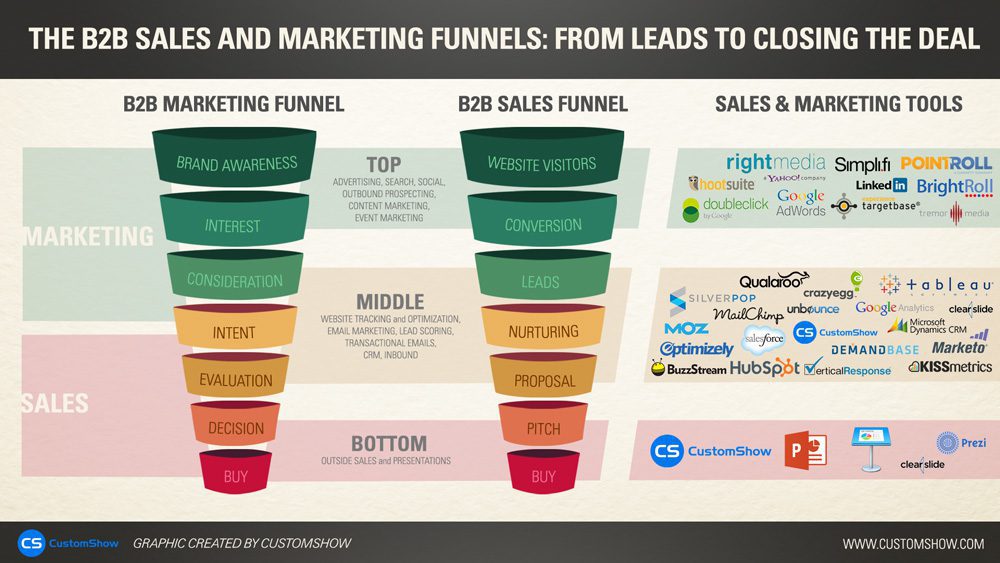The confluence of sales and marketing continues to take shape every day as companies work to integrate the two. There remain strong similarities between the marketing and sales funnel and the overall functions of each. Companies are spending billions of dollars on marketing tools, including solutions like a free virtual number, to help integrate sales and marketing functions while improving a company’s ability to communicate with prospects. By utilizing best B2B sales prospecting software like these, businesses can streamline communication, enhance lead generation, and foster stronger customer relationships. Many of these tools span all the way down to the proposal and pitch stage of the buying process. We wanted to create a graphic that depicted the cross-connection between the two while also showcasing the sales prospecting tools that can be used at each stage of the funnel.
Brand Awareness & Website Visitors –
The traditional marketer will consider the top of the marketing funnel the stage in which someone for the first time is interacting with your brand. This can occur through many avenues including traditional TV advertising all the way down to search and display advertising, but for most B2B companies that occurs when people land on your website. At this stage, marketers are pegged with the task of identifying marketing channels and platforms that will allow them to bring in more qualified prospects. including strategies like increasing TikTok likes and followers and other social media platform engagements. The sales team does not have as much responsibility at this stage of the process other than communicating on objections they traditionally get from converted leads, with additional visibility often enhanced through the installation of digital signage.
Interest & Conversion –
At this point, the web visitor has their interest peaked and now the job of a conversion optimizer or brand owner is to convert them. We can’t just start off by selling to them but we can educate them on the product/solution while giving them more reasons to want to interact further with the company. The buyer is showing interest by further engaging with your brand, but they haven’t made as much an effort to further investigate.
Consideration & Leads –
At this stage, the web visitor is now seriously considering your product/solution and wants to learn more by engaging with the company. For sales teams and at this stage, these individuals have turned into leads for the company. The onus is now shifting from the marketing team over to the sales team to further nurture the prospect and engage with them.
Intent & Nurturing –
We are now moving from a marketing role to more of a sales role. We are looking to educate the prospect and warm them up to the idea of purchasing from us. More of the responsibility is being placed on the sales team to convert that prospect into a potential customer. But in order to be effective, sales teams must implement a form of lead scoring to determine who’s really serious and who’s not. In addition, the sales teams must continue to communicate to educate the prospect. They can use multiple channels to accomplish this from social media to email marketing. Emails are the best channel to educate your customers. In email marketing, you need to follow the right email validation process to get the best results.
Evaluation & Proposal –
Buyers in the B2B world will evaluate your pricing and offer based on a proposal that is submitted. Those proposals are submitted and compared to proposals from other organizations. In the mindset of the buyer, they are still evaluating their options but the sales team must go through its own discovery phase to figure out what’s important to the buyer so it’s being addressed in both the proposal and the pitch.
Decision & Pitch –
While marketing places a limited role at this stage, the buyer is looking to make an informed decision. He may have been in touch with other companies and thus has put your firm on the shortlist to pitch. For that reason, presentation software that wows and impresses the audience is critical to the success of any marketing and sales campaign. The sales teams at this stage are utilizing their tool of choice to come in and showcase their product/service to the buyer.
Purchase/Buy –
At this stage, there is a confluence between the sales and marketing funnels. All the hard work placed by both the sales and marketing teams occurs at this stage. A sales team cannot close more deals without more opportunities. And a marketing team cannot have success without a sales team “converting” those leads and prospects into customers. The hope is that both sales and markets have done its job in improving the conversions at each stage of the funnel by utilizing traditional marketing and sales skills while implementing tools and collecting user and customer feedback along the way that will allow them to be effective.
Sales and marketing have always played an important role in working together to bring in more ready customers to organizations. The two do not and should not work in a vacuum. It’s like a relay race in which the marketing team will pay the baton over to the sales team. There are many tools on the market that are meant to help the teams collaborate, be more effective, and produce more buyers. As marketing and sales continue to evolve, we will continue to see the two departments meld into one.
Every good presentation is a good presentation builder that fit the intricacies and identity of your organization. At CustomShow, we believe our presentation software can do just that.

